Why invest in warehouse worker safety?
The U.S. warehousing and storage industry employs over 1,000,000 workers in more than 17,000 locations. In Canada, that figure is nearly 500,000. As a result, the safety of warehouse workers is of great concern to occupational health and safety managers.
In 2020, there were 24,900 nonfatal injuries. In 2021, the average workplace injury rate in the warehousing industry was 4 per 100 full-time workers. And unfortunately, the fatal injury rate is higher than the national average for other industries.
The Occupational Safety and Health Administration (OSHA) reports that among fatal and nonfatal injuries, the six most common causes related to injuries in the warehouse are:
- Slips and falls
- Exposure to toxic substances
- Exhaustion and repetitive movements
- Vehicle collisions and accidents
- Falling objects
- Fires and explosions
The Risks of Unsafe Warehousing
Warehouse safety risks encompass various potential dangers and hazards within a warehouse environment that can threaten the well-being of workers, the integrity of stored goods, and overall operational efficiency. Warehouse workers face risks from unsafe use of forklifts, improper stacking of goods, and lack of personal protective equipment (PPE) and fire protection protocol.
Think about this — when one of your workers is absent due to an injury, the rest of your team and your operations are affected. To mitigate these risks, warehouse operators should prioritize safety, implement proper training programs, regularly inspect equipment and facilities, and adhere to relevant regulations and standards. Regular risk assessments and continuous improvement efforts are essential for maintaining a safe and efficient warehouse environment. In this article, we’ll look at ways to promote warehouse safety; here are 10 safety tips for warehouse workers:
nbsp
1. Provide Effective Personal Protective Equipment (PPE)
Personal protective equipment, known as “PPE,” refers to the equipment and clothing required to minimize risk levels and ensure workers’ health and safety. According to the CNESST (Commission des normes, de l’équité, de la santé et la sécurité du travail), PPE should be used as a last resort when the hazard cannot be reduced or eliminated in an acceptable manner using administrative measures or engineering control measures.
This safety equipment is intended to protect the parts of the body most susceptible to danger, such as the head, hands, skin, and eyes. Here are some examples of the most common PPE:
| PROTECTION | EXAMPLES |
| Eyes and face (including the respiratory tract) |
|
| Head |
|
| Hands and arms |
|
| Feet and legs |
|
| Body |
|
| Hearing |
|
Certain types of personal protective equipment must always be worn. In contrast, others may vary depending on the work environment and the tasks. But they all have the same objective, which is to reduce the exposure of workers to risks, such as:
- Dropping sharp or heavy objects
- Extreme weather conditions
- Foreign particles projected into the eyes, nose, or mouth
- Splashes of corrosives on the skin, likely to cause chemical burns
- Continuous machinery noise that can damage the eardrums
OSHA and the CNESST agree that the employer is responsible for providing personal protective equipment that must be appropriately fitted to the worker. Using PPE improperly is just as dangerous as having none.
The employer is also responsible for training their employees on, among other things, the use, maintenance, disposal, and restrictions of personal protective equipment.

2. Train staff on machinery, ergonomics, and work methods
Did you know that heavy machinery (like forklifts and heavy pallets) is the leading cause of warehouse injuries and sometimes death? And that the unsafe use of forklifts in warehouse operations is the most common OSHA-sanctioned hazard.
In the United States, approximately 95,000 employees are injured annually due to forklifts. Even the Commission de la santé et de la sécurité du travail du Québec indicates that forklift upsets cause the most significant number of fatal accidents. This is why you should not rely on workers to learn safety while on the job. It is essential to train, supervise, and assess workers in the safe use of equipment and vehicles, but also to inform them of the associated risks to make them aware of the dangers.
Here are some other valuable tips for using dangerous machines or tools:
- Inspect tools before use
- Check that the machinery is equipped with protective equipment
- Repair faulty equipment
- Ensure safe handling of sharp objects
- Follow lockout procedures during conveyor systems maintenance and repair
On another note, did you know that work-related musculoskeletal disorders (WMSDs), also called repetitive strain injuries (RSI), are among the most frequently reported causes of absenteeism at work? These injuries can be caused by, among other things, repetitive movements, improper lifting methods, exhaustion, or poor posture.
In Québec, more than 45,000 workers in all industries have a musculoskeletal disorder (MSD) every year, resulting in compensation costs of $500 million. The number of injured workers, the severity of the WMSDs generated, and the related costs could be considerably reduced by training workers on ergonomic methods.
The employer can also implement the following measures in the warehouse:
- Store goods strategically
- Use automation tools
- Ensure task rotation and teamwork
- Optimize workflow and workplaces
- Use the services of an ergonomics expert
On the other hand, you should also adopt various other safety guidelines to reduce workplace accidents. For example, informing employees about the proper methods of stacking goods is essential. Falling items could crush a worker, causing injury or even death.
Also, remember to show workers how to use a Safety Data Sheet (SDS) for each chemical they are exposed to in your warehouse. In addition to containing information about health, fire, reactivity, and environmental hazards, the SDS also indicates how to handle and store the product to prevent chemical burns safely.
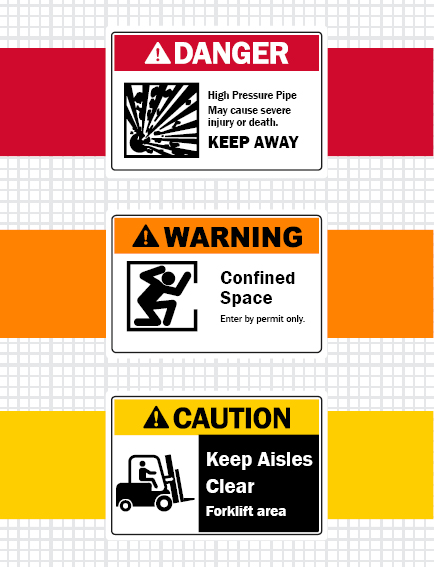
3. Identify dangerous locations, equipment, and tools
Proper signage in your warehouse helps prevent mistakes that can cause minor injuries or even severe accidents. There are various types of signage recommended by the CSA (Canadian Standards Association) and the OSHA, such as:
- Aisle and row signposts
- Warning signs for forklifts
- “Danger, flammable materials” signs
- Health and safety signs
- Exit signs
- Signs indicating locations reserved for authorized personnel
- Signs indicating the requirement to wear specific PPE
- Load capacity plates
OSHA’s “Hazard Communication Standard” also provides for the addition of pictograms on hazardous materials labels to warn users of the chemical to which they could be exposed.
In addition to installing the necessary signs, remember to identify forklift traffic lanes to prevent collisions. Also, install warning signs near the edge of the platforms. To prevent falls, affix a bar as visible as possible along the edge of the loading docks (often in bright yellow).
The aisles reserved for pedestrian traffic must also be indicated. Some establishments do this with floor paint or signs. In contrast, others install barriers to separate pedestrians from equipment in the aisles.
Remember that signage does not serve as a decorative element. Proper posters and signs keep your warehouse safe, encourage efficient working methods, and can even save lives.
4. Educate staff on how to keep their workplaces clean and organized
A clean warehouse is about more than making workplaces welcoming. It can also promote productivity and reduce waste—but most importantly, prevent occupational health and safety problems, including injuries and fires.
Did you know that in Québec, from 2010 to 2019, 11.4% of workers’ absence days in the warehousing sector were due to falls from the same level? This percentage includes, among other things, falls related to floors, walkways, or ground surfaces, as well as waste, scrap, or debris.
To prevent the risk of slipping, tripping, or falling in your warehouse, you should:
- Ensure that aisles and traffic lanes are in good condition and free of obstacles
- Dispose of trash and recyclable materials promptly
- Check that work areas are clean and tidy
- Clean up spills immediately and have a spill control plan in place
- Attach the cables
- Remove anything that poses a tripping hazard
Therefore, proper housekeeping in the workplace prevents incidents related to tripping, falling objects, slipping, etc. It is crucial to ensure that warehouse personnel is constantly vigilant. These cleaning and tidying tasks must be shared by all and carried out daily.
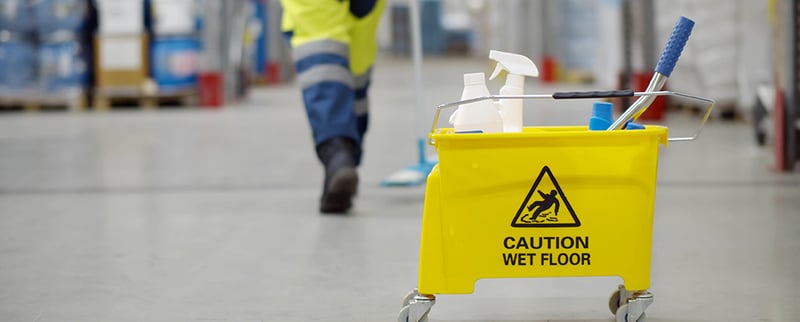
5. Optimize warehouse environmental conditions
Poor air quality can lead to various health problems and reduce worker productivity and focus. A ventilation system can often be deficient in establishments with confined spaces, windowless work areas, poorly maintained ventilation equipment, or those wishing to maximize energy efficiency.
Since forklifts emit carbon monoxide, a poisonous gas, it can affect your workers’ health. Be sure to install exhaust fans to prevent vehicle fumes or exhaust from stagnating and enough alarms to avoid carbon monoxide poisoning.
Air circulation must be designed to remove contaminants from indoor air and allow air to circulate within the establishment for better humidity and temperature control. For example, add fans to promote air mixing in a heated or air-conditioned warehouse with a high ceiling. It will prevent warm air from rising to the top and cool air settling on the floor.
To optimize your employees’ working conditions, you can also give them, when necessary, noise-canceling headsets as well as a uniform suitable for very high or very low temperatures (for example, when working in cold storage). Inadequate lighting can also be a safety hazard and affect productivity. Ensure an appropriate illumination level to prevent injuries or accidents caused by low visibility in your warehouse.
6. Plan for regular warehouse inspections
An effective risk control plan makes it possible to assess actual or potential dangers in your workplace, take corrective measures, and develop methods to prevent such incidents from recurring.
Therefore, it is strongly recommended that inspections be conducted periodically to identify occupational health and safety risks. You can guarantee safe work practices and, above all, ensure you determine and correct unsafe conditions and procedures.
The frequency of your inspections may vary depending on your type of operations, the extent of the risks, the history of workplace injuries, your employees’ expertise, and the extent of changes made to work methods or equipment.
Create a warehouse safety checklist and update it as you go. This list should include all of the safety items to check during your inspection to help you conduct a thorough review and not forget essential tasks, such as:
- Emergency exits
- Warehouse layout
- Machinery
- Protective equipment (for conveyors, among others)
- Warehouse facilities
- Loading docks
- Electricity
- General cleanliness of work areas
- Tangled wires and debris accumulation
Consult your workers about their current working conditions and possible risks to their health and safety. Since they are involved in your warehouse’s day-to-day operations, they are in the best position to help you create a safe working environment.
Employees can provide feedback to let you know what needs improvement, what procedures aren’t being followed, and anything else important about your warehouse. And most importantly, don’t neglect their mental health; ask them about psychological health risks, such as a lack of breaks at work or working long hours.
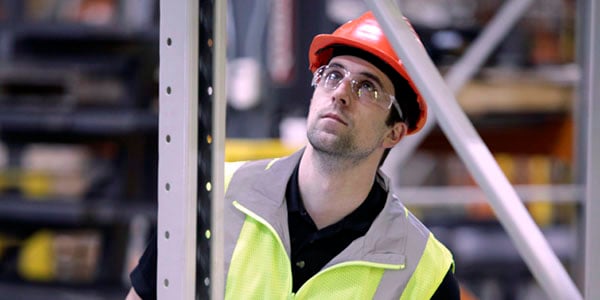
7. Create and maintain a safety incident log
Keeping records is essential. According to the Loi sur les accidents du travail et les maladies professionelles, the employer must log all industrial accidents in their establishment. It is also to their advantage to note the incidents there to prevent other accidents of the exact nature.
To get a clear idea about the situation in an establishment, you can record in a log minor or potentially serious incidents, the frequency of injuries, as well as the specific location where these injuries occurred.
In writing, the employer is responsible for identifying the risks to which workers are exposed, and noting possible prevention and control measures. The CNESST provides an inspection and prevention sheet template that describes the dangers and indicates the suggested corrections and actions to be taken to prevent them from happening again.
Rescuers must indicate all illnesses, injuries, and first aid administered. It is essential that all other workers also participate in prevention efforts. They must respect safety measures, indicate the risks in their workplace, and suggest ways to improve their health and safety at work.
An accident log is an essential tool for the employer. With this document, they can implement effective prevention and first aid measures.
ARE YOU TRAINED IN WAREHOUSE SAFETY?
DISCOVER HOW OUR PALLET RACK SAFETY TRAINING CAN
EQUIP YOUR WORKERS TO IDENTIFY HAZARDS AND
RESPOND APPROPRIATELY IN CASE OF DAMAGE.
8. Put a first-aid plan in place
Despite all the precautionary measures, an accident may still occur. To be best prepared for this situation, employees must be trained in first aid and always present on the premises. The CNESST even provides some financial assistance to workers who wish to take first aid training in the workplace.
The employer of an establishment is responsible for registering workers selected for training and posting their names in a visible place. They must also ensure an adequate number of trained first aiders on-site, according to the number of workers per shift.
| Number of workers | Number of first aiders required |
| 50 workers or less | 1 first aider |
| Between 51 and 150 workers | 2 first aiders |
| More than 151 workers | Add one first aider for every 100 workers |
The employer must also furnish an adequate number of first-aid kits, which varies according to the number of workers. The kit must be clean, complete, in good condition, and located near the work area. After each use, the kit should be checked, and any missing equipment replaced.
Here are examples of the contents of a good first-aid kit:
- Gauze pads/compresses
- Bandages and tape
- Wipes for cleaning wounds
- Scissors and tweezers
- Cover(s)
- Latex gloves
- Resuscitation equipment
In addition, according to CNESST regulations, the employer of an establishment with more than 100 workers must provide a room for first-aiders. This room must be easily accessible during working hours, adequately ventilated, lighted, heated, and clean.
No one wants an accident or injury to happen, but it is a possibility. This is why it is essential to be prepared.
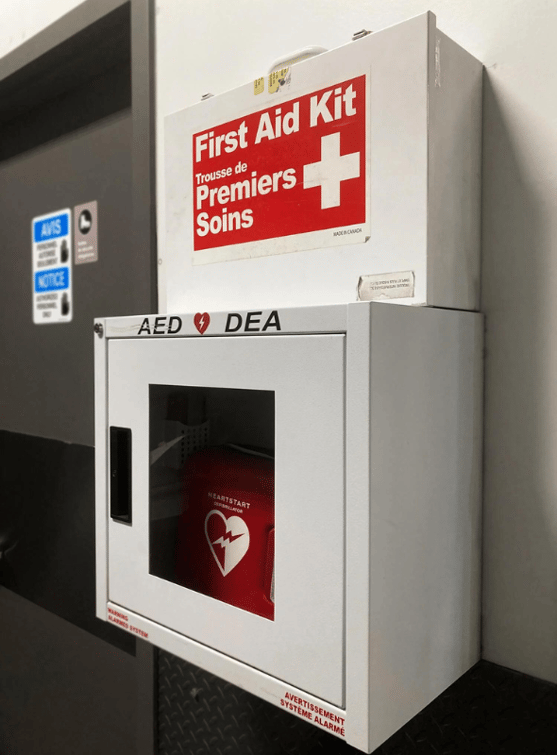
9. Schedule an plan emergency drills
It is essential to develop an emergency response plan to apply it calmly in advance rather than panic in an emergency, such as a fire, flood, chemical spill, etc.
No matter how detailed your action plan is, it would be best if you also implemented other protective measures in your warehouse, for example:
- Review the evacuation plan annually
- Install emergency lighting
- Indicate emergency exits clearly and strategically
- Remove obstacles to exit routes
- Determine the stakeholders and their responsibilities
- Display a map of the premises in a visible place and choose the meeting place
- Reduce the risk of fire
- Regularly test smoke alarms and install fire extinguishers
However, more than a response plan is required. You must also inform workers of safety measures and conduct several emergency drills annually.
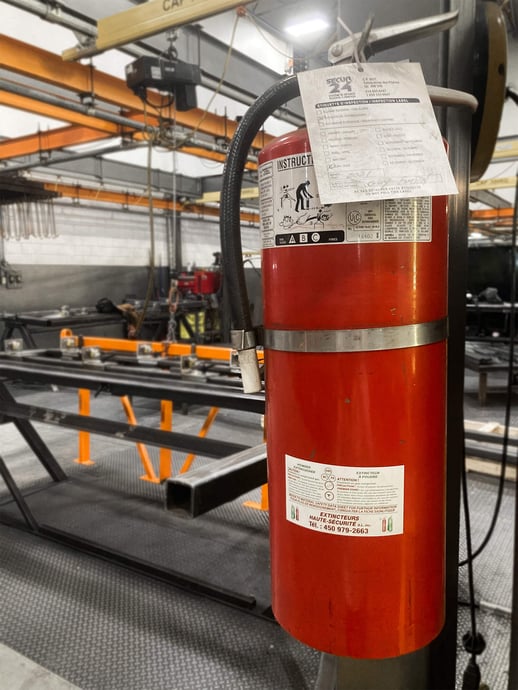
10. Ensure the safety of storage racks
According to OSHA, the employer must provide a work environment free from known hazards. While the agency doesn’t provide clear guidelines for rack safety, you still need to recognize the hazards and take proactive steps to avoid them. When systems are improperly used, installed, or maintained, the risk of injury increases and employers must assume heavy liability in the event of an accident (see the Criminal Code of Canada).
Did you know that collisions with a forklift cause 90% of damages to warehouse rack systems? Components of a damaged rack can collapse, increasing the risk of falling objects on workers. In addition to causing injuries and sometimes even the death of employees, an entire pallet rack that collapses could have a domino effect — it could collapse on top of another one until the warehouse infrastructure is seriously affected.
This is why it is strongly suggested to protect the pallet racks at the base to reduce the risk of damage, mainly due to forklifts. This protection aims to prevent their collapse and protect the warehouses from damage on a larger scale, promoting employee safety.
To prevent objects from falling, remember to affix labels or plates indicating the load capacity of the pallet racks, i.e., the maximum weight authorized to be placed on the pallet rack. And above all, have experts conduct frequent inspections of your pallet rack systems.
The Benefits of Implementing Rack Safety Tips
U.S. transportation and warehousing companies spend approximately $84 million weekly on nonfatal workplace injuries.
The consequences can be important for both the employer and their workers:
- Negative impacts on employee health and safety
- Decreased employee morale
- Increased insurance costs
- Loss of productivity and income
- Hefty fines for non-compliance
- Damage to the company’s reputation
- Costs related to warehouse accidents can be high (compensation, medical, legal costs, hiring and training new employees, etc.)
So, as the CNESST says, health and safety are everyone’s business. To keep staff safe at work, you must strengthen your safety culture to cultivate a sense of shared responsibility. Invest in training your staff on warehouse safety to reduce the incidence of damage. This will go a long way to help keep everyone safe in your warehouse.
Sources:
https://www.ccohs.ca/oshanswers/ergonomics/lighting_survey.htmlhttps://www.cnesst.gouv.qc.ca/en/prevention-and-safety/first-aid-workplace/first-aid-workplace-program
https://incord.com/material-handling-nets/warehouse-rack-safety/
https://www.cnesst.gouv.qc.ca/sites/default/files/documents/dc900-801web_1.pdf
https://www.cnesst.gouv.qc.ca/en/prevention-and-safety/first-aid-workplace/who-pays-what-first-aid-workplace
https://www.cnesst.gouv.qc.ca/en/node/1165426/personal-protective-equipment
https://laws-lois.justice.gc.ca/eng/regulations/SOR-86-304/page-24.html
https://www.ccohs.ca/oshanswers/diseases/rmirsi.html
https://www.ccohs.ca/newsletters/hsreport/issues/2008/03/ezine.html
https://www.osha.gov/sites/default/files/publications/osha2236.pdf
https://www.osha.gov/sites/default/files/publications/OSHA3491QuickCardPictogram.pdf
https://www.osha.gov/sites/default/files/publications/carbonmonoxide-factsheet.pdf
https://www.osha.gov/sites/default/files/publications/3220_Warehouse.pdf
https://www.osha.gov/laws-regs/regulations/standardnumber/1910/1910.266AppA
https://www.osha.gov/personal-protective-equipment
https://www.thompsons.law/support/legal-guides/common-warehouse-accidents-and-how-to-avoid-them
https://www.bls.gov/iif/nonfatal-injuries-and-illnesses-tables/case-and-demographic-characteristics-table-r1-2020.htm
https://www150.statcan.gc.ca/t1/tbl1/en/tv.action?pid=1410020201
https://www.cnbc.com/2022/04/12/study-amazon-workers-suffer-serious-injuries-at-twice-rate-of-rivals.html
https://www.cnesst.gouv.qc.ca/sites/default/files/publications/prevenir-les-troubles-musculosquelettiques.pdf
https://www.cnesst.gouv.qc.ca/sites/default/files/publications/registre-accidents-incidents-et-premiers-secours.pdf
https://www.cnesst.gouv.qc.ca/sites/default/files/publications/prevention-petite-et-moyenne-entreprise.pdf
https://www.viaprevention.com/wp-content/uploads/2017/09/Guide-Pri%C3%A8re-de-ne-pas-renverser-2016.pdf https://risquesdelesions.cnesst.gouv.qc.ca/pages/statistiquelesions.aspx?DescAccENS=6&SCIAN=488490&vue=ENSEMBLE_SECTEUR












